第四单元知识点总结
第四单元知识点梳理

第四单元梳理一、重点词语睁眼、翻身、斧头、劈柴、缓慢、浑浊、丈量、支撑、精疲力竭、劳累、血液、奔流不息、茂盛、滋润、溺水、返回、衔接、悲惨、猛兽、敬佩、坚定、违抗、铁环、门锁、既然、狠心、著名、收获、愤愤不平、驱寒取暖、气急败坏、风吹雨淋、欢声笑语、黑黝黝喷涌而出、惊慌失措、花圃、花卉、花蕾、花蕊、玫瑰、茉莉、牡丹、海棠腾云驾雾(孙悟空)、上天入地(孙悟空)、神机妙算(诸葛亮)、各显神通(八仙过海)、三头六臂(哪吒)、神通广大(女娲)、未卜先知(姜子牙)、刀枪不入(《葫芦兄弟》三娃)二、人物形象:盘古:雄伟高大、勇于开创、无私奉献精卫:锲而不舍、坚持不懈、不怕困难普罗米修斯:为民造福、不畏强权、不惜牺牲自己宙斯:心狠手辣、冷酷无情、霸道专制火神赫淮斯托斯:有正义感但比较软弱大力士赫拉克勒斯:有正义感、敢作敢为女娲:善良勇敢、甘于奉献三、神话人物拓展:古希腊神话中勇敢的大力士赫拉克勒斯,用音乐征服草木万物的俄耳甫斯;永远挂着迷人微笑的北欧光明之神巴德尔,爱恶作剧的火神洛基;还有敢捉弄北风的美洲辛格比。
四、出自神话故事的成语嫦娥奔月、后羿射日、夸父逐日、精卫填海五、古诗嫦娥唐李商隐云母屏风烛影深,长河渐落晓星沉。
嫦娥应悔偷灵药,碧海青天夜夜心。
六、文言文阅读《精卫填海》炎帝/之少女,名曰/女娃。
女娃/游于东海,溺/而不返,故为/精卫,常衔/西山/之木石,以堙于/东海。
译文:炎帝的小女儿,名叫女娃。
女娃到东海去游玩,不幸在海里溺水而亡,再也回不来了,化作了精卫鸟,常常衔着西山的树枝和石子来填塞东海,想把东海填平。
(1)解释词语的意思:少女:小女儿。
故:因此。
溺:溺水,淹没。
堙:堵塞。
曰:叫做。
(2)精卫“常衔西山之木石,以堙于东海”的原因是:女娃游于东海,溺而不返,故为精卫。
(3)《精卫填海》选自《山海经·北山经》,我还知道里面收录的神话故事有:《夸父逐日》《大禹治水》等。
(4)从“常衔西山之木石,以堙于东海”中的“常”字可以领悟到精卫填海的决心、坚韧执着的品质。
数学第四单元的知识点总结
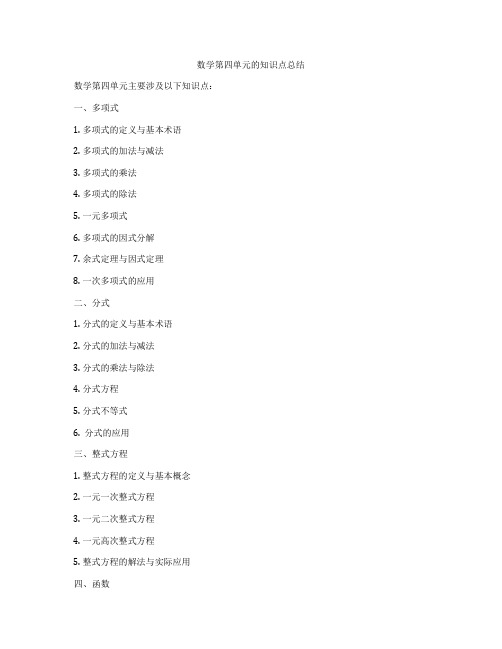
数学第四单元的知识点总结数学第四单元主要涉及以下知识点:
一、多项式
1. 多项式的定义与基本术语
2. 多项式的加法与减法
3. 多项式的乘法
4. 多项式的除法
5. 一元多项式
6. 多项式的因式分解
7. 余式定理与因式定理
8. 一次多项式的应用
二、分式
1. 分式的定义与基本术语
2. 分式的加法与减法
3. 分式的乘法与除法
4. 分式方程
5. 分式不等式
6. 分式的应用
三、整式方程
1. 整式方程的定义与基本概念
2. 一元一次整式方程
3. 一元二次整式方程
4. 一元高次整式方程
5. 整式方程的解法与实际应用
四、函数
1. 函数的概念与基本术语
2. 函数的性质与图像
3. 一次函数
4. 二次函数
5. 多项式函数
6. 有理函数
7. 指数函数与对数函数
8. 函数的应用
以上仅是数学第四单元知识点的简要概括,具体内容还需根据教材进行深入学习。
希望对你的学习有所帮助。
第四单元知识点梳理

第四单元考点梳理一、字词积积累1.读读写写恩情针线注视迟到永远叹气眼泪寸草心善良压力对付充饥孝心打败凶恶巨响扑进怀抱巾帼下达征兵理应战功将士将军丢失敌人抓住顺从受骗战土复仇起早贪黑习武练功救母心切2.易错字音孟郊(mèng) 缝衣裳(féng) 一针针(zhēn) 铭记(míng) 游子吟(yín) 气愤(fèn) 增添(zēng) 血痕(hén) 巾(jīn)国征兵( zhēng) 理应(yīng) 将士(jiàng) 将军(jiāng) 抓住(zhuā) 隐藏(yǐn) 受骗(piàn) 3.同音字组词针(针对) 注(注目) 救(救人) 饥(饥饿)真(真正) 住(居住) 就(就是) 机(机会)败(失败) 巾(毛巾) 征(征兵) 战(战士)拜(拜年) 今(今天) 争(斗争) 站(站立)4.形近字组词恩(恩情) 永(永远) 压(重压) 丢(丢失)思(思想) 水(河水) 庄(村庄) 去(来去)5.多音字缝 féng(缝补) fèng(门缝)应 yīng(应该) yìng(回应)将 jiàng(将士) jiāng(将军)燕 yàn(燕子) yān(燕山)埋 mái(埋伏) mán(埋怨)藏 cáng(隐藏) zàng(藏族)6.近义词铭记一一牢记告别一一离别气愤一一愤恨对付一一应付潜伏一一埋伏顺从一一听从主张一一主意复仇一一报仇增添一增加在乎一一在意探望一一看望凶恶一一凶狠7.反义词湿润一一干燥善良一一凶恶遥远一一附近胜利一一失败战争一一和平密一一稀顺从一一违背复仇一一报恩8.词语归类(1)填填动词(缝)衣裳 (披)战袍 (跨)骏马 (渡)黄河(过)燕山 (举起)神斧 (解救)妈妈 (冲)下来(2)填量词一(个)血泡一(道)血痕一(座)高山一(把)神斧一(声)巨响一(位)英雄雄一(条)山沟一(个)老乡(3)填填修饰词(又细又密)的针脚 (美丽善良)的女神 (心狠手辣)的二郎神(高强)的武艺 (高耸入云)的华山 (英勇善战)的花将军(文静俊美)的站娘 (美好)的生活 (复仇)的子弹(动人)的故事 (默默)地攥紧 (惊讶)地发现二、课文梳理1《母亲的恩情》是文包诗,以讲故事的形式自然地引入了古诗《游子吟》。
人教版八年级道德与法治上册第四单元《维护国家利益》知识点总结

人教版八年级道德与法治上册第四单元《维护国家利益》知识点总结8.1 国家好大家才会好1、国家利益的含义及重要性(作用)?P87含义:国家利益是一个主权国家在国际社会中生存需求和发展需求的总和,包括人口、领土、主权和政权等。
重要性和作用:它们关系到民族生存、国家兴亡。
2、国家利益涉及的领域和种类?P88国家利益涉及政治、经济、文化、社会、军事等领域,包括安全利益、政治利益、经济利益、文化利益等。
3、国家的核心利益包括哪些方面?P88国家核心利益包括国家主权、国家安全、领土完整、国家统一、宪法确立的国家政治制度和社会大局稳定、经济社会可持续发展的基本保障。
4、维护国家利益的重要意义?P89-90①在我们国家,国家利益反映广大人民的共同需求,是人民利益的集中表现。
国家利益至上,人民利益高于一切,二者相辅相成。
②人民利益只有上升、集中到国家利益,运用国家的工具,才能得到真正的维护。
国家独立自主、繁荣富强,国际地位提高,人民的生活就充满希望,内心就感到自豪和骄傲。
反之,如果国家利益得不到保障,人民的利益就会受到损害,人民就会遭到奴役、欺凌和屈辱。
③国家利益只有反映人民的利益,依靠人民艰苦奋斗,才能得到真正的实现。
每个人在自己平凡的岗位上辛勤劳动,推动着国家发展和社会进步。
④国家利益与人民利益是高度统一的。
实现中华民族伟大复兴最鲜明的特点,就是将国家和人民视为一个命运共同体,将国家利益和人民利益紧密联系在一起。
5、国家利益和人民利益的关系是怎样的?P89-90①在我们国家,国家利益反映广大人民的共同需求,是人民利益的集中表现。
国家利益至上,人民利益高于一切,二者相辅相成。
②国家利益与人民利益是高度统一的。
实现中华民族伟大复兴最鲜明的特点,就是将国家和人民视为一个命运共同体,将国家利益和人民利益紧密联系在一起。
8.2 坚持国家利益至上1、怎样树立维护国家利益意识?P91-93①坚持国家利益至上,我们要心怀爱国之情,牢固树立国家利益至上的观念,以热爱祖国为荣,以危害祖国为耻。
八年级物理第四单元知识总结

八年级物理第四单元知识总结
八年级物理第四单元的知识总结如下:
1. 光的传播:光在同种均匀介质中沿直线传播,光速约为3×10^8米/秒。
光的反射、折射、全反射等都是光的传播规律。
2. 光的反射:光在遇到障碍物时发生反射,反射光线与入射光线、法线在同一平面内,反射光线与入射光线分居法线两侧,反射角等于入射角。
3. 光的折射:光从一种介质斜射入另一种介质时,发生折射现象,折射光线与入射光线、法线在同一平面内,折射光线与入射光线分居法线两侧,折射角一般小于入射角。
4. 光的全反射:光从光密介质射入光疏介质,或光从真空射入介质时,当入射角增大到某一角度,反射光线会突然消失的现象。
5. 凸透镜成像:凸透镜使光线会聚,凸透镜可以成放大、倒立或正立的实像或虚像,物距大于焦距成倒立缩小的实像,物距小于焦距成正立放大的虚像。
6. 凹透镜成像:凹透镜使光线发散,凹透镜可以成缩小、正立的实像或虚像。
7. 光的偏振:横波的振动方向与传播方向垂直,光的偏振说明光是横波。
8. 光的干涉与衍射:光具有波动性,通过光的干涉和衍射现象可以研究光的波动性。
以上是八年级物理第四单元的知识总结,希望对您有所帮助。
初一四单元知识点总结

初一四单元知识点总结本单元的重点知识包括问路和指路、购物和交易以及日常生活常用语等方面的内容。
下面将对这些知识点进行总结。
问路和指路1. 问路的常用句型在问路时,我们可以使用一些固定的句型来询问路线,比如:- Excuse me, could you tell me how to get to the nearest bank?- Can you show me the way to the train station?- Where is the nearest bus stop, please?2. 指路的表达方式在指路时,我们可以使用一些词语和表达方式来告诉对方应该如何到达目的地,比如: - Go straight and turn left at the first crossing.- It's just round the corner on the right.- You can take the subway to get there.购物和交易1. 购物时的用语在购物时,我们需要学会使用一些有关购物的常用用语,比如:- How much is this shirt?- Do you have this in a larger size?- I'd like to return this pair of shoes.2. 交易中常用的表达方式在进行交易时,需要使用一些常用的表达方式来和商家进行沟通,比如:- Can I pay by credit card?- Could you give me a discount?- I'd like to exchange this for another one.日常生活常用语1. 日常用语的表达方式在日常生活中,我们需要使用一些常用的句型和表达方式来和他人进行交流,比如: - How are you doing?- What's the weather like today?- Have a nice day!2. 时间和日期的表达方式在描述时间和日期时,我们可以使用一些固定的表达方式来表达时间和日期,比如: - It's half past ten.- Today is Monday, the 5th of June.- What time is it now?以上就是初一英语第四单元知识点的总结,希望对大家的学习有所帮助。
第部编人教版一年级语文上册第四单元知识必记
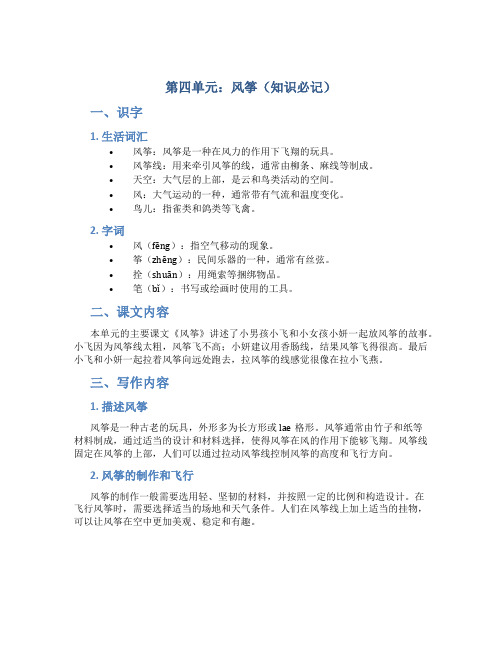
第四单元:风筝(知识必记)一、识字1. 生活词汇•风筝:风筝是一种在风力的作用下飞翔的玩具。
•风筝线:用来牵引风筝的线,通常由柳条、麻线等制成。
•天空:大气层的上部,是云和鸟类活动的空间。
•风:大气运动的一种,通常带有气流和温度变化。
•鸟儿:指雀类和鸽类等飞禽。
2. 字词•风(fēng):指空气移动的现象。
•筝(zhēng):民间乐器的一种,通常有丝弦。
•拴(shuān):用绳索等捆绑物品。
•笔(bǐ):书写或绘画时使用的工具。
二、课文内容本单元的主要课文《风筝》讲述了小男孩小飞和小女孩小妍一起放风筝的故事。
小飞因为风筝线太粗,风筝飞不高;小妍建议用香肠线,结果风筝飞得很高。
最后小飞和小妍一起拉着风筝向远处跑去,拉风筝的线感觉很像在拉小飞燕。
三、写作内容1. 描述风筝风筝是一种古老的玩具,外形多为长方形或lae格形。
风筝通常由竹子和纸等材料制成,通过适当的设计和材料选择,使得风筝在风的作用下能够飞翔。
风筝线固定在风筝的上部,人们可以通过拉动风筝线控制风筝的高度和飞行方向。
2. 风筝的制作和飞行风筝的制作一般需要选用轻、坚韧的材料,并按照一定的比例和构造设计。
在飞行风筝时,需要选择适当的场地和天气条件。
人们在风筝线上加上适当的挂物,可以让风筝在空中更加美观、稳定和有趣。
3. 风筝的文化意义风筝不仅是一种娱乐活动,还具有深厚的文化内涵。
在中国传统文化中,风筝有着象征吉祥、祈福和追求自由的含义。
人们放风筝不仅是为了放飞自己的心情,也是希望风筝飞得越高越好,寓意着希望家庭事业兴旺、生活稳定幸福。
四、名称解释在本单元中,“风筝”一词的意思是指为了风筝的高飞,同时也为了家庭、学习和生活等方面都能顺利前进,获得成功和幸福的象征。
五、诗词赏析《蜻蜓》蜻蜓轻舒细翅,微风轻抚葱草,风筝高飞似金龙;筝声飘扬催心赏,文墨斜日是良辰。
六、必背习题1.用一句话概括《风筝》这篇课文的主题。
2.对比描述小飞用粗线和用细线放风筝的不同情况。
第四章 居民与聚落(核心知识梳理)-七年级地理上期中(人教版)

第四章居民与聚落核心知识梳理【思维导图】
【知识梳理】
考点一:世界的人口
1.世界人口的增长:
(1)人口总数:2022年11月15日,全球人口达到80亿。
(2)人口增长进程:
(3)人口自然增长率=出生率—人口死亡率。
表示人口的增长速度。
(4)人口增长的地区差异
2.世界人口的分布:
(1)人口密度表示人口的疏密程度。
(2)世界人口的分布
①特点:人口分布很不均匀
②人口稠密区:中低纬度的沿海平原地区
③人口稀疏区:干旱的荒漠、寒冷的极地、空气稀薄的高山高原、原始的热带雨林等自然环境恶劣地区
3.世界的人口问题:
(1)人口数量过多,增长过快
措施:实行控制生育政策
(2)人口数量过少,增长过慢
措施:鼓励生育
考点二:世界的人种
1.气温的变化:
(1)三大人种:根据体质方面的特征,人类可以分为白种人、黄种人和黑种人三个主要人种。
(2)不同人种的特征及分布
考点三:世界的语言和宗教
1.世界的语言:
2.世界的三大宗教:
考点四:世界的聚落1.聚落的形式:
2.聚落的形成条件:
3.聚落与自然环境:
4.世界文化遗产的保护:
(1)保护世界文化遗产的意义:有些聚落从不同角度记录着当时的历史、政治、文化、民俗等信息,便于后人了解当时的人们的生活状况。
(2)被列入《世界遗产名录》的聚落:法国巴黎塞纳河沿岸、意大利的威尼斯城、我国山西省的平遥古城、云南省的丽江古城、安徽省的皖南古村落、澳门历史城区。
部编版二年级上册第四单元知识整理
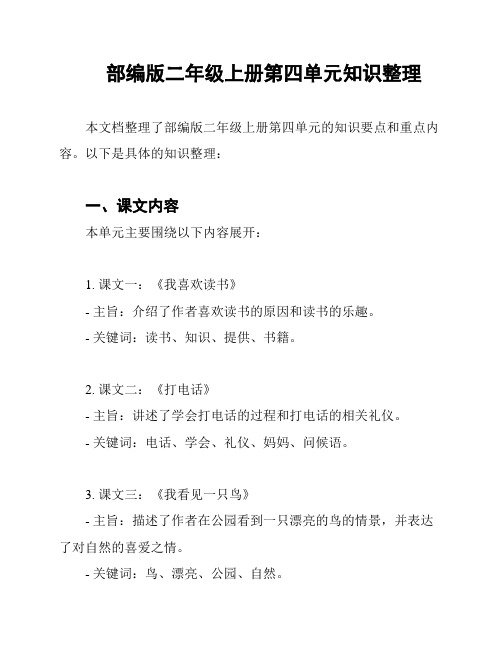
部编版二年级上册第四单元知识整理
本文档整理了部编版二年级上册第四单元的知识要点和重点内容。
以下是具体的知识整理:
一、课文内容
本单元主要围绕以下内容展开:
1. 课文一:《我喜欢读书》
- 主旨:介绍了作者喜欢读书的原因和读书的乐趣。
- 关键词:读书、知识、提供、书籍。
2. 课文二:《打电话》
- 主旨:讲述了学会打电话的过程和打电话的相关礼仪。
- 关键词:电话、学会、礼仪、妈妈、问候语。
3. 课文三:《我看见一只鸟》
- 主旨:描述了作者在公园看到一只漂亮的鸟的情景,并表达了对自然的喜爱之情。
- 关键词:鸟、漂亮、公园、自然。
4. 课文四:《风筝》
- 主旨:描绘了作者放风筝的过程和风筝的魅力。
- 关键词:风筝、飞翔、线、纸。
二、重点词汇
本单元涉及到一些重点词汇,包括但不限于:
1. 喜欢
2. 读书
3. 知识
4. 提供
5. 书籍
6. 打电话
7. 学会
8. 礼仪
9. 妈妈
10. 问候语
11. 鸟
12. 公园
13. 自然
14. 风筝
15. 飞翔
16. 线
17. 纸
请根据课文内容和重点词汇,进行针对性的研究和复,以便更好地掌握本单元的知识。
以上是部编版二年级上册第四单元的知识整理,希望对你的学习有所帮助!。
语文第四单元知识点总结
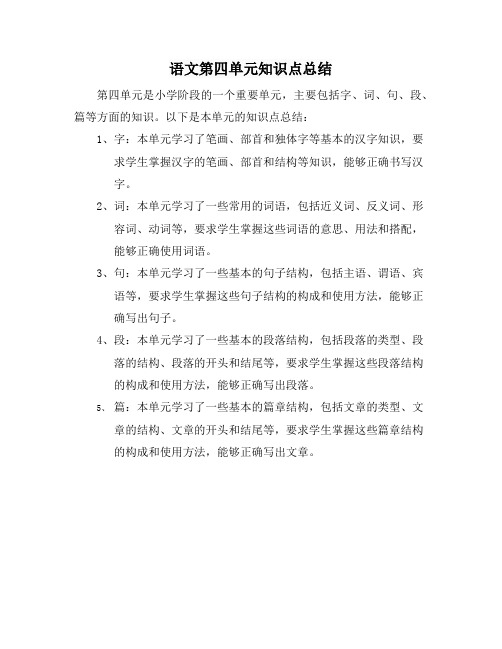
语文第四单元知识点总结
第四单元是小学阶段的一个重要单元,主要包括字、词、句、段、篇等方面的知识。
以下是本单元的知识点总结:
1、字:本单元学习了笔画、部首和独体字等基本的汉字知识,要
求学生掌握汉字的笔画、部首和结构等知识,能够正确书写汉
字。
2、词:本单元学习了一些常用的词语,包括近义词、反义词、形
容词、动词等,要求学生掌握这些词语的意思、用法和搭配,
能够正确使用词语。
3、句:本单元学习了一些基本的句子结构,包括主语、谓语、宾
语等,要求学生掌握这些句子结构的构成和使用方法,能够正
确写出句子。
4、段:本单元学习了一些基本的段落结构,包括段落的类型、段
落的结构、段落的开头和结尾等,要求学生掌握这些段落结构
的构成和使用方法,能够正确写出段落。
5、篇:本单元学习了一些基本的篇章结构,包括文章的类型、文
章的结构、文章的开头和结尾等,要求学生掌握这些篇章结构
的构成和使用方法,能够正确写出文章。
一年级上册第四单元知识要点
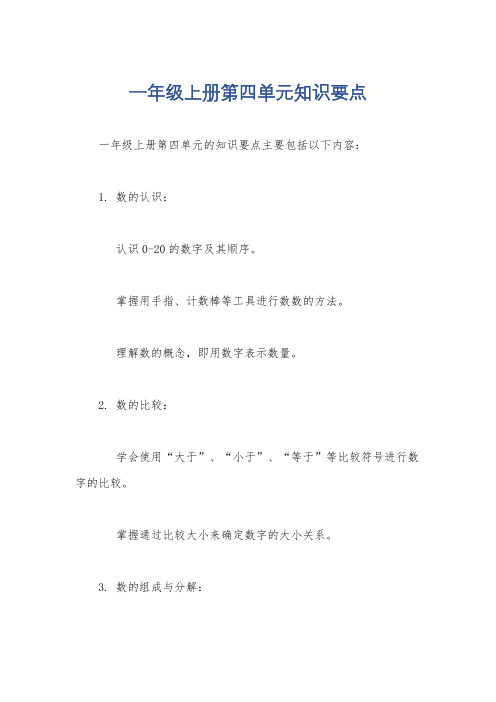
一年级上册第四单元知识要点一年级上册第四单元的知识要点主要包括以下内容:
1. 数的认识:
认识0-20的数字及其顺序。
掌握用手指、计数棒等工具进行数数的方法。
理解数的概念,即用数字表示数量。
2. 数的比较:
学会使用“大于”、“小于”、“等于”等比较符号进行数字的比较。
掌握通过比较大小来确定数字的大小关系。
3. 数的组成与分解:
理解十位和个位的概念,掌握两位数的组成。
学会将两位数分解成十位数和个位数的和。
4. 数的运算:
掌握加法的概念和符号“+”,能够进行简单的加法计算。
理解加法的交换律和结合律。
5. 数的排序:
学会按照从小到大或从大到小的顺序排列数字。
掌握使用比较符号进行数字的排序。
6. 数的应用:
了解数的应用在日常生活中的重要性,如购物、计算时间等。
运用数的概念和技巧解决实际问题。
以上是一年级上册第四单元的知识要点,通过学习这些内容,学生能够建立起对数字的基本认识和运用能力,为后续数学学习打下坚实的基础。
第四单元自然界的水 知识点总结

第四单元自然界的水【知识点1】自然界的水1.人类拥有的水资源的分布:海洋约占96.5%,淡水约占2.53%,可用淡水约占淡水总量的30.4%,大部分不可用。
我国水资源分布不均,人均水量少。
2.爱护水资源:(1)节约用水;(2)防止水体污染。
3.水污染来源:(1)工业“三废”(废渣、废液、废气);(2)生活污水的任意排放;(3)农药、化肥的不合理施用。
4.消除水污染:(1)工业三废要经处理达标后再排放;(2)生活污水要集中处理达标后再排放,提倡零排放;(3)合理施用农药、化肥,提倡使用农家肥。
5、水的净化方法⑴沉淀法包括静置沉淀和使用絮凝剂(如明矾)的吸附沉淀,可除去部分不溶性杂质;⑵过滤起到使不溶性杂质与水完全分离的作用;⑶吸附可除去水中的有色、有异味的杂质;⑷消毒一般使用漂白粉杀死水中的病毒和细菌;⑸是净水程度最高的方法,生活中可降低水的硬度。
6.过滤:一贴:滤纸紧贴漏斗内壁;二低:滤纸边缘低于漏斗口、液面低于滤纸边缘;三靠:烧杯口紧靠玻璃棒、玻璃棒下端紧靠滤纸的三层处、漏斗下端紧靠烧杯内壁。
7.硬水与软水(1)硬水:含有较多可溶性钙、镁化合物的水。
例如:江水等。
(2)软水:不含或含较少可溶性钙、镁化合物的水。
例如:蒸馏水等。
(3)硬水与软水的鉴别方法:用肥皂水,有浮渣产生或泡沫较少的是硬水,泡沫较多的是软水。
(4)硬水软化的方法:蒸馏、煮沸。
【知识点2】水的组成(1)水的物理性质:无色、无味的透明液体;在1.01×105Pa时,水的沸点为℃,水的凝固点为℃;在1.01×105Pa下,℃时的水密度最大,为1.0g/mL,冰的密度小于水的密度。
水能够溶解很多物质,是化学常用的溶剂。
(2)电解水实验现象:与正极相连的试管内产生的气体同与负极相连的试管内产生的气体的体积比约为1∶2。
(3)电解水实验气体(正氧负氢)的检验:与正极相连的试管中的气体能使带火星的木条复燃,是氧气;与负极相连的试管中的气体能燃烧,火焰呈淡蓝色(气体量少,可能发出爆鸣声),是氢气。
四年级英语下册 《第四单元》要掌握的知识点

3.Those are tomatoes and potatoes over there.
在那边的那些是西红柿和土豆。
4.My father has ten sheep on the farm.
我父亲的农场里有十只绵羊。
5.A:What are those?那些是什么?
B:They are horses.它们是马。
6.A:Are they hens?它们是母鸡吗?
7.B: No, they aren’t. They are ducks.
不,它们不是母鸡。它们是鸭子。
8.A: How many horses do you have ?你有多少匹马啊?
B: Seventeen.十七匹马。
翻译:大家好!欢迎来到我的农场。它非常大!看!这是蔬
菜园。这些事胡萝卜和土豆。在那边的那些是西红柿和豆角。我很喜欢西红柿。我的农场里还有很多动物。看!那些是羊和牛。它们喜欢吃草!
这些是什么? 那些是Байду номын сангаас么?
12.区分开“farm(农场)”和“farmer(农民)”的意思
↓ ↓
on the farm(在农场) He is a farmer.(他是一个农民)
13.vegetable蔬菜(复数+s=vegetables)
如:What vegetables do you like best ?你最喜欢什么蔬菜?
14.animal动物(复数+s=animals)
如:What animals do you like best ?你最喜欢什么动物?
二、重点句子,需记忆,会连词成句
高中政治必修四第4单元知识点总结
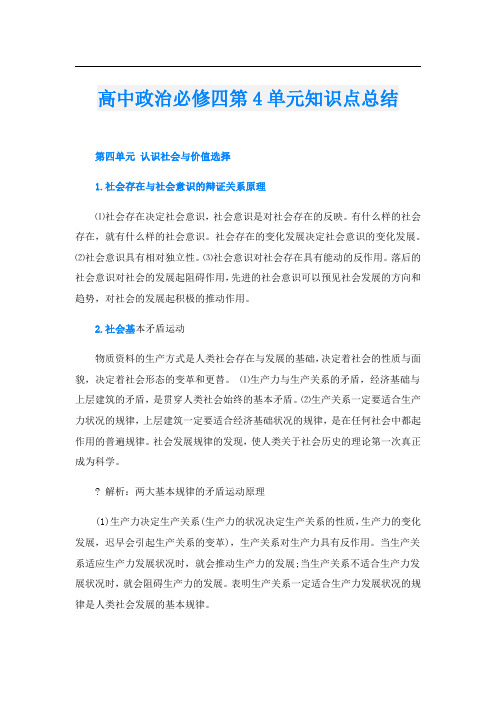
高中政治必修四第4单元知识点总结第四单元认识社会与价值选择1.社会存在与社会意识的辩证关系原理⑴社会存在决定社会意识,社会意识是对社会存在的反映。
有什么样的社会存在,就有什么样的社会意识。
社会存在的变化发展决定社会意识的变化发展。
⑵社会意识具有相对独立性。
⑶社会意识对社会存在具有能动的反作用。
落后的社会意识对社会的发展起阻碍作用,先进的社会意识可以预见社会发展的方向和趋势,对社会的发展起积极的推动作用。
2.社会基本矛盾运动物质资料的生产方式是人类社会存在与发展的基础,决定着社会的性质与面貌,决定着社会形态的变革和更替。
⑴生产力与生产关系的矛盾,经济基础与上层建筑的矛盾,是贯穿人类社会始终的基本矛盾。
⑵生产关系一定要适合生产力状况的规律,上层建筑一定要适合经济基础状况的规律,是在任何社会中都起作用的普遍规律。
社会发展规律的发现,使人类关于社会历史的理论第一次真正成为科学。
? 解析:两大基本规律的矛盾运动原理(1)生产力决定生产关系(生产力的状况决定生产关系的性质,生产力的变化发展,迟早会引起生产关系的变革),生产关系对生产力具有反作用。
当生产关系适应生产力发展状况时,就会推动生产力的发展;当生产关系不适合生产力发展状况时,就会阻碍生产力的发展。
表明生产关系一定适合生产力发展状况的规律是人类社会发展的基本规律。
(2)经济基础决定上层建筑,上层建筑对经济基础具有反作用。
当上层建筑适合经济基础状况时,就会促进经济基础的巩固和完善;当上层建筑不适合经济基础状况时,就会阻碍经济基础的发展和变革。
当上层建筑为先进的经济基础服务时,它就促进生产力的发展,推动社会进步;当它为落后的经济基础服务时,则束缚生产力的发展,阻碍社会前进。
表明上层建筑一定要适合经济基础发展的规律是人类社会发展的又一基本规律。
3.社会历史发展的总趋势社会历史发展的总趋势是前进的、上升的,发展的过程是曲折的。
社会发展是在生产力和生产关系、经济基础和上层建筑的矛盾运动中、在社会基本矛盾的不断解决中实现的。
数学第4单元知识点总结

数学第4单元知识点总结第一节直线1. 直线的概念及特征直线是一个没有拐弯的连续的路径,它有无限多个点构成,且任意两点都能够确定一条直线,直线在平面上没有起点和终点。
2. 点斜式方程直线的点斜式方程为 y = kx + b,其中 k 为直线的斜率,b 为直线的截距。
3. 截距式方程直线的截距式方程为 y = mx + c,其中 m 为直线的斜率,c 为直线在 y 轴上的截距。
4. 两点式方程直线的两点式方程为 (x - x1)/(x2 - x1) = (y - y1)/(y2 - y1),其中 (x1, y1) 和 (x2, y2) 为直线上的两个点。
第二节直线与角1. 同位角同位角是指两条直线被一条第三条直线所截成的两组相对位置相同的角。
2. 对顶角对顶角是指两条直线被一条第三条直线所截成的两组相对位置相同的角。
3. 直角直角是指两条直线相交,形成的两组相对位置相同的角,每一组角的两个角度之和等于90 度。
第三节角度1. 角度的概念角度是以某一点为顶点,以两条射线为边的图形,常用度(°)来表示。
2. 角的度数转化角度的度数可以转化为弧度制,1 度 = π/180 弧度,也可以转化为百分度,1 度 = 100 百分度。
3. 角的三要素角的三要素包括顶点、始边和终边,始边为顶点的射线,终边为角度的另一条射线。
第四节三角形1. 三角形的概念及特征三角形是一个有三条边和三个顶点的多边形,它有三个内角和三个外角,三角形的内角和等于 180 度。
2. 三角形的分类三角形根据边的长短和角的大小可以分为:等边三角形、等腰三角形、直角三角形、锐角三角形、钝角三角形等。
3. 三角形的性质三角形的性质包括:内角和是180度;外角和是360度;三边之间的关系等。
第五节三角形的相似1. 三角形的相似判定两个三角形相似的判定条件包括:AAA 判定法、侧边比判定法、角边边判定法。
2. 相似三角形的性质相似三角形的性质包括:对应角相等,对应边成比例,相似三角形的高与底的比例相等。
七年级上册英语第四单元知识点
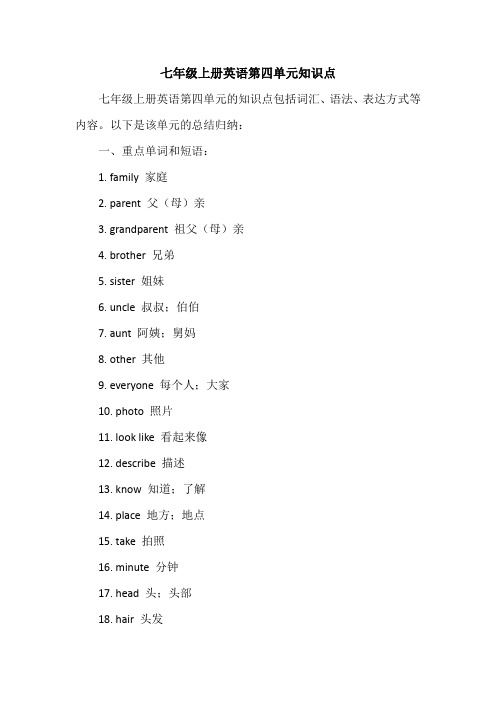
七年级上册英语第四单元知识点七年级上册英语第四单元的知识点包括词汇、语法、表达方式等内容。
以下是该单元的总结归纳:一、重点单词和短语:1. family 家庭2. parent 父(母)亲3. grandparent 祖父(母)亲4. brother 兄弟5. sister 姐妹6. uncle 叔叔;伯伯7. aunt 阿姨;舅妈8. other 其他9. everyone 每个人;大家10. photo 照片11. look like 看起来像12. describe 描述13. know 知道;了解14. place 地方;地点15. take 拍照16. minute 分钟17. head 头;头部18. hair 头发19. face 脸;面部20. nose 鼻子21. mouth 嘴;口部22. eye 眼睛23. ear 耳朵24. arm 胳膊;手臂25. hand 手26. leg 腿;腿部27. foot 脚;足部28. toe 脚趾29. dress 连衣裙;女装30. blouse 女衬衫31. skirt 裙子;短裙32. sock 短袜;袜子33. boot 长筒靴;皮靴34. buy 购买;购买(动词)35. expensive 昂贵的;高价的(形容词)36. cheap 便宜的;廉价的(形容词)37. size 号;尺寸(名词)38. color 颜色(名词)39. black 黑色(形容词及名词)40. white 白色(形容词及名词)41. red 红色(形容词及名词)42. green 绿色(形容词及名词)43. blue 蓝色(形容词及名词)44. yellow 黄色(形容词及名词)45. put on 穿上(动词短语)46. take off 脱下(动词短语)47. have on穿着(动词短语)有些英语老师会教have on = be wearing,但是实际上二者还是有区别:have on是动词短语,可以用于祈使句和一般现在时态中,而be wearing则侧重于现在进行时态,且不用于祈使句。
部编版四年级上册语文第四单元 单元知识小结

部编版四年级上册语文第四单元单元知识小结
一、课文内容回顾
1. 《谁是贤者》
在第四单元的第一篇课文《谁是贤者》中,通过讲述孔子问徒弟谁是贤者的故事,使学生了解什么是真正的贤者,涵义深刻,引人思考。
2. 《草船借箭》
第二篇课文《草船借箭》讲述了周瑜在对抗曹军时的聪明与勇气,引导学生学
习乐于助人,善于变通的道理。
二、生字词总结
本单元涉及了一些生字词,包括但不限于:“贤者”、“信徒”、“脾气”、“箭矢”等,在学习过程中,应该注意掌握这些生字词的意思和用法,以提高阅读理解能力。
三、词语解析与造句
1.“贤者”指的是有才德、有智慧的人,“谁是贤者”的问题,激发了学生
对贤者的思考。
2.“箭矢”在《草船借箭》中扮演着关键的角色,周瑜成功地借箭,充分
展示了他的智谋和胆识。
四、课文情感体会
通过学习本单元的课文,学生应该对待人相亲、乐意助人,同时要懂得变通、
善于分析问题,从而培养学生的美德和实践能力。
五、笔记整理
整理文本和课文中的重点内容,包括关键词、生字词、人物关系、情节逻辑等,以便于复习和加深对课文的理解。
六、学习体会
在学完本单元的课文之后,我们不仅学到了古代贤者的品质和行为,还了解了
智者的聪明才智。
通过这些古人的故事,启发我们学习做人、做事的态度和方法。
结语
在部编版四年级上册语文第四单元中,我们不仅学习了优秀的古代文学作品,
还培养了自己的道德观和品质。
希望同学们能够在学习过程中认真思考,积极实践,不断提高自己的修养和能力。
第四单元知识点归纳总结

第四单元知识点归纳总结
一、扇形统计图的意义:
1、扇形统计图的意义:
用整个圆的面积表示总数,用圆内各个扇形面积表示各部分数量与总数之间的关系。
也就是各部分数量占总数的百分比(因此也叫百分比图)。
2、从扇形统计图中获取信息:
读懂扇形统计图的主题、内容,根据扇形的大小或各部分所占的百分比大小比较各部分大小,还可以根据已知信息计算得出未知信息。
3、扇形统计图各部分的百分比之和是100%,也就是“1”。
4、扇形的面积大小:
①求每个扇形的具体数量。
用整个圆的总数量X小扇形的百分比=小扇形的具体数量
②已知小扇形的具体数量和百分比,求圆的总数量
小扇形的具体数量÷所对应的百分比=圆的总数量(单位“1”)
二、常用统计图的优点:
1、条形统计图:可以清楚的看出各种数量的多少。
2、折线统计图:不仅可以看出各种数量的多少,还可以清晰看出
数量的增减变化情况。
3、扇形统计图:能够清楚的反映出各部分数量与总数之间的关系。
4、复式折线统计图用点表示数量的多少,用线段反映数量的增减变化,复式折线统计图,不仅能看出数量的增减变化,而且便于两组相关数据进行比较。
人教版六年级上册第四单元知识点归纳时间和日常活动
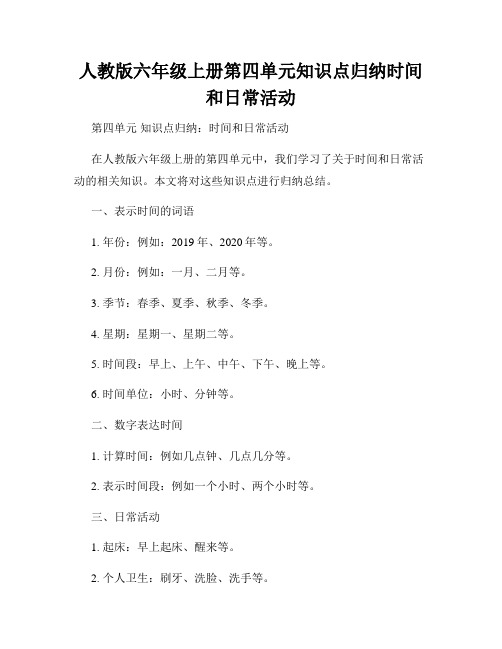
人教版六年级上册第四单元知识点归纳时间和日常活动第四单元知识点归纳:时间和日常活动在人教版六年级上册的第四单元中,我们学习了关于时间和日常活动的相关知识。
本文将对这些知识点进行归纳总结。
一、表示时间的词语1. 年份:例如:2019年、2020年等。
2. 月份:例如:一月、二月等。
3. 季节:春季、夏季、秋季、冬季。
4. 星期:星期一、星期二等。
5. 时间段:早上、上午、中午、下午、晚上等。
6. 时间单位:小时、分钟等。
二、数字表达时间1. 计算时间:例如几点钟、几点几分等。
2. 表示时间段:例如一个小时、两个小时等。
三、日常活动1. 起床:早上起床、醒来等。
2. 个人卫生:刷牙、洗脸、洗手等。
3. 进行餐饮:吃早餐、午餐、晚餐、喝牛奶等。
4. 上学:走路上学、坐车上学等。
5. 学习:上课、听讲等。
6. 课外活动:体育课、音乐课、美术课、跳绳等。
7. 休息时间:午休、放学等。
8. 睡觉:晚上睡觉、睡觉前洗漱等。
四、时间状语1. 表示频率:每天、有时候、经常等。
2. 表示顺序:首先、然后、最后等。
3. 表示时态:现在、过去、将来等。
五、对日常活动的提问和回答1. 提问方式:什么时候、几点等。
2. 回答方式:用具体的时间或时间状语回答。
六、其他相关知识点1. 小时的计算:60分钟=1小时。
2. 学会读时间:掌握小时和分钟的读法。
3. 各种活动的时常:不同活动所需时间的差异。
以上是人教版六年级上册第四单元的时间和日常活动的知识点归纳。
通过本单元的学习,我们可以更好地理解和运用时间的概念,并描述日常活动的发生时间。
希望同学们能够继续努力,熟练掌握这些知识,提高自己的中文水平。
- 1、下载文档前请自行甄别文档内容的完整性,平台不提供额外的编辑、内容补充、找答案等附加服务。
- 2、"仅部分预览"的文档,不可在线预览部分如存在完整性等问题,可反馈申请退款(可完整预览的文档不适用该条件!)。
- 3、如文档侵犯您的权益,请联系客服反馈,我们会尽快为您处理(人工客服工作时间:9:00-18:30)。
Unit 4知识目标高频词Australia,footprint,wet,kick,town,blow,everything,trip,shine,dry,brightly,picnic,snowy,spend,relative,during,grandparents高频词组take a trip,go on a picnic,make snowman,fly kites,go swimming,havea picnic语法1.能在名词前正确使用形容词2.能在be动词后正确使用形容词3.学会运用句型:It is +adj.+(for sb.)to do sth.【单词·要点】1.often 副词,意为“时常,经常”,一般用于行为动词之前,be动词或助动词之后,有时也用于句末以加强语气。
辨析often,always,usually与sometimesoften 意为“时常,经常”表示动作重复,中间有间断;表示发生的频率比usually要低,但比sometimes要高always 意为“总是,永远地”表示动作重复、状态继续,中间没有间断usually 意为“通常,平常”很少有例外,发生的频率仅次于always sometimes 意为“有时”表示动作偶尔发生。
可以位于句首,以示强调2.spend 及物动词,意为“花(时间)”,其后常与介词on/in连用,spend的主语必须是人,常用于一下结构:①“spend + 表示时间/金钱的名词(短语)+ on + 名词”结构表示“花费多少时间/金钱做某事”。
e.g.They want to spend five years on the bridge.②“spend + 表示时间/金钱的名词(短语)+(in)doing sth.”结构表示“花费多少时间/金钱做某事”。
e.g.She spends all day (in) learning English.3.knock 敲;敲打。
接宾语时常先接介词on或at。
e.g.Someone is knocking on/at the door.Ex.I usually spend half an hour my homework every night.A.atB.inC.onD.to【短语·要点】1.watch sb. do sth. 看某人做某事,强调动作的全过程。
e.g.I watch him get on the bus.watch sb. doing sth. 看某人正在做某事,强调动作正在进行中。
e.g.I watch her cleaning the classroom.Ex.I’m watching him a kite.A.flyingB.to flyC.fliesD.is flying2.start意为“开始”。
start to do sth.和start doing sth.表示“开始做某事”,一般情况下两者可以互换,但下列情形中,要注意其区别:start doing sth. 用在当谈论一项长期的、习惯性的活动时start to do sth. 用在当start本身为进行时态时用在当start后接表示心理状态或精神活动的动词时用在当主语是物而不是人时e.g.I start learning English.I’m starting to cook the di nner.Mary starts to guess what is in the bag.3.take a trip 意为“去旅行”。
take 常和名词连用,意为“做....事情”,表示与该名词意义相关的动作。
take a trip 也可以说成have a trip,类似的词组还有:take/have a rest休息一下take/have a walk散步take/have a swim 游泳take/have a look看一看4.have fun 过得愉快,玩得高兴,相当于have a good time/enjoy oneself。
fun是不可数名词,表示“娱乐,乐趣”。
常用于have fun doing sth.结构中,意为“愉快地做某事”。
e.g.We have fun flying the kites.5.get married意为“结婚”,与be married 同义。
get/be married to sb. 与某人结婚。
注意此时to不能改为with。
e.g.He wants to get married to a teacher.【拓展】①marry sb. 表示“嫁给某人/与某人结婚”。
e.g.Mr White is going to marry an actress.②marry sb. to sb. 表示“(父母把女儿)嫁给某人”或“(父母为儿子)娶媳妇”。
e.g.She wants to marry her son to a rich man.6.put forward 把.....向前拨e.g.You can put your forward ten minutes.【拓展】put forward的其他用法:①向前移e.g.Why don’t you put your chair forward.②将....提前e.g.We have to put the meeting forward.③提出e.g.Please put forward a new plan.【句子·要点】1.What about you? 你呢?what about ...? 意为“....怎么样”,与How about...?同义。
常用于询问消息、征求意见或建议,其后可以跟名词、代词或v.-ing形式。
e.g.What/How about going home now?2.See how deep The puddles get.看水坑变得多深。
这是一个含有宾语从句的复合句,从句由疑问副词how引导,从句的语序是陈述语序。
the puddles 是从句的主语,get是谓语。
e.g.I want to know how he goes to school.3....Sandy footprints Made by me. ....被我踩出串串沙滩足迹。
句中made by me 是过去分词短语,放在所修饰的名词footprints的后面,作后置定语,表示被动的含义。
e.g.Do you know the girl named Jenny? 你知道那个名叫詹妮的女孩吗?4.At 1 a.m. on that day,the socks in all pubilc places in the UK are put forward an hour,from 1a.m. to 2 a.m.在那天的凌晨一点,英国所有公共场所的钟表被向前拨一个小时,从一点调到两点。
这是一个含有一般现在时的被动句。
被动语态表示被动意义,即主语是谓语动词所表示的动作的承受者。
一般现在时的被动语态的构成:be(am/is/are)+及物动词的过去分词。
e.g.The boy is often hit.这个男孩经常挨打。
【用法集萃】1.like...best 最喜欢....2.in spring 在春天3.get warm 变暖4.send out 发出5.go on a picnic=have a picnic 去野餐6.at this time of year 在每年的这个时候7.make snowmen 堆雪人8.the Spring Festival 春节9.have dinner 吃晚饭10.on Monday morning 在星期一上午11.plant trees 植树12.during the day 在白天13.in the north of China 在中国北部14.at thar time 在那时Ex.( )1.He’s from .He’s an Australian.A.AustralianB.AustraliansC.AustraliaD.australia( )2.Look!The are falling from the tree.A.leafB.leafsC.leavesD.leafes( )3.Everything going well.A.amB.isC.areD./( )4.I visit my friends the Spring Festival.A.inB.atC.duringD.on( )5.There are people in the park.A.a lotB.lot ofC.a lots ofD.a lot of( )6.There is snow today.A.bigB.heavyC.heavilyD.strongly【语法专项】形容词的用法1.形容词表示人或事物的性质、状态,一般置于它所修饰的名词之前作定语,或联系动词之后作表语。
作定语大多数形容词作定语修饰名词时,其位置在被修饰的名词前,说明名词的品质或特征当形容词所修饰的名词是由some,any,every,no等构成的复合不定代词时,形容词必须置于所修饰的词之后enough等形容词修饰名词时可前置也可后置作表语常位于连系动词be(am,is,are),feel,get,turn等后面,说明主语的特征、状态或身份e.g.She’s a tall girl. I would like something cheap.We have enough time/time enough. He is happy and I feel sad.2.名词变为形容词的方法:①在名词后面加-y可以变成形容词(尤其是一些与天气有关的名词)。
如rain-rainy,cloud-cloudy,wind-windy,snow-snowy,health-healthy,luck-lucky等。
②少数以不发音的e结尾的名词变为形容词时,应去掉e再加-y。
如noise-noisy,ice-icy。
3.It is+形容词+动词不定式(短语)在这个句型中,常用interesting,exciting,nice,easy,difficult等形容词。
e.g.It is important to listen to the teacher carefully in class.【拓展】①在此句型中,如果要说明动词不定式(短语)的动作是谁做的,可在动词不定式(短语)前加一个for引起的短语,作动词不定式(短语)的逻辑主语。
